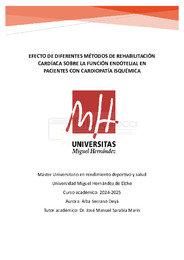Please use this identifier to cite or link to this item:
https://hdl.handle.net/11000/37464Full metadata record
| DC Field | Value | Language |
|---|---|---|
| dc.contributor.advisor | Sarabia, José M. | - |
| dc.contributor.author | Serrano Deyá, Alba | - |
| dc.contributor.other | Departamentos de la UMH::Ciencias del Deporte | es_ES |
| dc.date.accessioned | 2025-09-23T11:56:13Z | - |
| dc.date.available | 2025-09-23T11:56:13Z | - |
| dc.date.created | 2025-06 | - |
| dc.identifier.uri | https://hdl.handle.net/11000/37464 | - |
| dc.description.abstract | Las enfermedades cardiovasculares son la principal causa de mortalidad mundial, manifestándose con mayor frecuencia el infarto agudo de miocardio. La principal consecuencia fisiológica tras sufrir un infarto es la disfunción endotelial. Actualmente, la rehabilitación cardíaca se presenta como una herramienta efectiva para mejorar la calidad de vida. Sin embargo, no existe un consenso sobre qué tipo de entrenamiento aeróbico es más beneficioso para recuperar la función endotelial. Por ello, en este estudio se presenta un diseño experimental para comparar tres formas de entrenamiento aeróbico (HIT largo, HIT corto y MIT) en pacientes con cardiopatía isquémica. Esta intervención dura 12 semanas y estará ajustada en base a los umbrales ventilatorios VT1 y VT2. La función endotelial se evaluará mediante la técnica de dilatación mediada por flujo (FMD), utilizando ecografía Doppler. El principal objetivo es determinar que modalidad ofrece mayores mejoras en la recuperación vascular tras sufrir un evento cardiovascular. Cardiovascular diseases are the leading cause of mortality worldwide, with acute myocardial infarction being the most frequent. The main physiological consequence after an infarction is endothelial dysfunction. Currently, cardiac rehabilitation is presented as an effective tool for improving quality of life. However, there is no consensus on what type of aerobic training is most beneficial to recover endothelial function. Therefore, in this study we present an experimental design to compare three forms of aerobic training (long HIT, short HIT and MIT) in patients with ischemic heart disease. This intervention lasts 12 weeks and will be adjusted based on ventilatory thresholds VT1 and VT2. Endothelial function will be assessed by the flow-mediated dilatation (FMD) technique using Doppler ultrasound. The main objective is to determine which modality offers the greatest improvement in vascular recovery after cardiovascular event. | es_ES |
| dc.format | application/pdf | es_ES |
| dc.language.iso | spa | es_ES |
| dc.publisher | Universidad Miguel Hernández de Elche | es_ES |
| dc.rights | info:eu-repo/semantics/openAccess | es_ES |
| dc.rights | Attribution-NonCommercial-NoDerivatives 4.0 Internacional | * |
| dc.rights.uri | http://creativecommons.org/licenses/by-nc-nd/4.0/ | * |
| dc.subject | Infarto de miocardio | es_ES |
| dc.subject | Rehabilitación cardíaca | es_ES |
| dc.subject | Función endotelial | es_ES |
| dc.subject | Ejercicio aeróbico | es_ES |
| dc.subject | Entrenamiento interválico | es_ES |
| dc.subject | Myocardial infarction | es_ES |
| dc.subject | Cardiac rehabilitation | es_ES |
| dc.subject | Aerobic exercise | es_ES |
| dc.subject | Endothelial function | es_ES |
| dc.subject.other | CDU::7 - Bellas artes::79 - Diversiones. Espectáculos. Cine. Teatro. Danza. Juegos.Deportes | es_ES |
| dc.title | Efecto de diferentes métodos de rehabilitación cardíaca sobre la función endotelial en pacientes con cardiopatía isquémica | es_ES |
| dc.type | info:eu-repo/semantics/masterThesis | es_ES |

View/Open:
SERRANO DEYÁ, ALBA_TFM_24-25.pdf
556,63 kB
Adobe PDF
Share:
.png)
